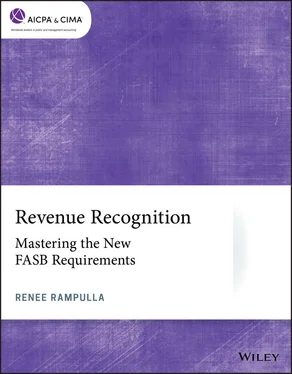For information about the procedure for requesting permission to make copies of any part of this work, please email copyright-permission@aicpa-cima.com with your request. Otherwise, requests should be written and mailed to Permissions Department, 220 Leigh Farm Road, Durham, NC 27707-8110 USA.
ISBN 978-1-119-76378-9 (Paper)
ISBN 978-1-119-76393-2 (ePDF)
ISBN 978-1-119-76392-5 (ePub)
ISBN 978-1-119-76394-9 (oBook)
Course Code: 746324
INRR GS-0419-0A
Revised: March 2019
Chapter 1 Revenue Recognition - The Need for Change
Learning objectives
Identify why the Financial Accounting Standards Board (FASB) and the International Accounting Standards Board (IASB) initiated a joint project to develop a single principle-based revenue standard.
Identify when part or all of a contract with the customer is outside the scope of FASB ASC 606, Revenue from Contracts with Customers.
Identify the five core principles described in FASB ASC 606.
Revenue is an important performance metric used by preparers, investors, lenders, and several other financial statement users to measure an entity’s past performance, financial health, and future prospects. Prior to the issuance of the revenue recognition standard, generally accepted accounting principles in the United States of America (US GAAP) lacked detailed disclosures about an entity’s revenue-generating activities and contained a wide variety of requirements and concepts for specific transactions and industries, sometimes resulting in different accounting treatments for similar transactions. Difficulty in applying revenue guidance was not limited to US GAAP; those entities using IFRS as their financial reporting framework also found challenges due to the limited guidance available.
Given the diversity, complexity, and importance of revenue, regulators heavily scrutinize revenue and the topic has been the subject of several fraud cases around the globe. Because revenue is so susceptible to fraud, auditors presume that a risk of fraud will exist and therefore revenue is specifically addressed in paragraphs .A33-.A35 of AU-C section 240, Consideration of Fraud in a Financial Statement Audit (AICPA Professional Standards ).
In October 2002, FASB and the IASB (collectively referred to as the boards) initiated a joint project to develop a single principle- based revenue standard. This joint project, along with several other projects, were announced in a memorandum of understanding, commonly referred to as the “Norwalk Agreement.” To increase the usefulness of revenue information to users of the financial statements, this agreement included a discussion on the boards’ plans to
remove inconsistencies and weaknesses in existing revenue requirements.
provide a more robust framework for addressing revenue issues.
improve comparability of revenue recognition practices across entities, industries, jurisdictions, and capital markets.
provide more useful information to users of financial statements through improved disclosure requirements.
simplify the preparation of financial statements by reducing the number of requirements to which an entity must refer.
To learn more, consider referring to FASB’s revenue recognition section of their website at fasb.org.
Subsequent to the release of the Norwalk Agreement, and over the course of two years, the boards issued the following three exposure drafts for public comment:
Revenue from Contracts with Customers, exposed on June 24, 2010.
Revenue from Contracts with Customers (re-exposed), on November 14, 2011.
Revenue from Contracts with Customers—Proposed Amendments to the FASB Accounting Standards Codification, exposed on January 4, 2012.
After three exposure drafts, numerous comment letters, and public outreach, on May 28, 2014, the boards issued joint accounting standards on revenue recognition addressing concerns regarding the complexity and lack of consistency when accounting for revenue transactions. Consistent with each board’s policy,
the IASB issued International Financial Reporting Standard (IFRS) 15, Revenue from Contracts with Customers, and
FASB issued Accounting Standards Update (ASU) No. 2014-09, Revenue from Contracts with Customers (Topic 606), whichamended the FASB Accounting Standards Codification® (ASC) by creating FASB ASC 606, Revenue from Contracts with Customers,added a new subtopic, FASB ASC 340-40,provided a principle-based framework for revenue recognition, andsuperseded FASB ASC 605, and either superseded or amended several existing revenue recognition requirements, including industry-specific topics within the FASB ASC 900 (Industry) sections.
 Key point
Key point
Keep in mind that ASU No. 2014-09 and IFRS 15 are considered converged standards. Most differences between US GAAP and IFRS when accounting for revenue from contracts with customers have been eliminated, with only a few exceptions in discrete areas.
1 ASU No. 2014-09 brought about which of the following:Created FASB ASC 606, Revenue from Contracts with Customers.Eliminated FASB ASC 340-40.Provided a rules-based framework for recognizing revenue.Increased several existing revenue recognition requirements and industry-specific topics within the FASB ASC 900 (Industry) sections.
Subsequent to the issuance of ASU No. 2014-09, FASB issued several ASUs to address stakeholders’ concerns, provide clarification, simplify and provide other guidance. The following paragraphs summarize the ASUs; excluded are SEC-only releases and ASUs discussed elsewhere in this course.
ASU No. 2015-14, Revenue from Contracts with Customers (Topic 606): Deferral of the effective date
This ASU was issued in order to provide stakeholders with sufficient time to implement the guidance in FASB ASC 606 by deferring the effective date of ASU No. 2014-09 for all entities by one year.
ASU No. 2016-04, Liabilities - Extinguishments of liabilities (Subtopic 405-20): Recognition of breakage for certain prepaid stored-value products (a consensus of the Emerging Issues Task Force)
Potential diversity in practice existed when a third party issued a prepaid product in exchange for cash or other consideration. In response, FASB issued this ASU to clarify that a prepaid product issued in exchange for cash or other consideration is considered a financial liability in accordance with the guidance in FASB ASC 405-20, with the narrow exception of breakage. Breakage is described as the amount of a prepaid product that is not used, for example a gift card, and would be considered within the scope of FASB ASC 606. Any changes brought about by the issuance of this ASU correspond to the applicable existing transition and effective dates of ASU No. 2014-09.
ASU No. 2016-08, Revenue from Contracts with Customers (Topic 606): Principal versus agent considerations (Reporting Revenue Gross versus Net)
This ASU clarifies implementation guidance related to principal versus agent transactions within the scope of FASB ASC 606; specifically, when another party, in addition to the entity, is involved in providing a good or service to a customer. An entity’s determination of whether it is a principal or agent depends on whether the entity obtains control before transferring the good or providing the service to a customer. Amendments in this ASU provide indicators of control and helpful illustrative examples. Clarifications brought about by the issuance of this ASU correspond to the applicable existing transition and effective dates of ASU No. 2014-09.
Читать дальше

 Key point
Key point










